 W
WThe Ahiram sarcophagus was the sarcophagus of a Phoenician King of Byblos, discovered in 1923 by the French excavator Pierre Montet in tomb V of the royal necropolis of Byblos.
 W
WThe Amman Citadel Inscription is the oldest known inscription in the so-called Ammonite language. It was discovered in 1961 in the Amman Citadel, and first published in full in 1968 by Siegfried Horn. The inscription is now in the Jordan Archaeological Museum. At the time of its discovery it was the third longest Semitic stone inscription ever found in the macro-area of Israel / Palestine / Jordan, after the Mesha Stele and the Siloam inscription. The inscription is known as KAI 307.
 W
WThe Aramaic Inscription of Taxila 'is an inscription on a piece of marble, originally belonging to an octagonal column, discovered by Sir John Marshall in 1915 at Taxila, British India. The inscription is written in Aramaic, probably by the Indian emperor Ashoka around 260 BCE, and often categorized as one of the Minor Rock Edicts. Since Aramaic was the official language of the Achaemenid empire, which disappeared in 330 BCE with the conquests of Alexander the Great, it seems that this inscription was addressed directly to the populations of this ancient empire still present in northwestern India, or to border populations for which Aramaic remained the normal communication language. The inscription is known as KAI 273.
 W
WThe Arslan Tash amulets are talismans found at Arslan Tash in northwest Syria, the site of ancient Hadatu. They are to be distinguished from larger finds such as the Arslan Tash reliefs. The inscriptions on the tablets are known as KAI 27.
 W
WThe Assur ostracon is an Aramaic inscription found in six fragments during the 1903-13 excavations of Assur by the Deutsche Orient-Gesellschaft. It is thought to be a letter addressed by an Assyrian official to one of his colleagues. It is one of the earliest known examples of Aramaic cursive script, including ligatures.
 W
WThe Baalshillem Temple Boy, or Ba'al Sillem Temple Boy, is a votive statue of a "temple boy" with a Phoenician inscription known as KAI 281. It was found along with a number of other votive statues of children near the canal in the Temple of Eshmun in 1963-64 by Maurice Dunand, and is currently in the National Museum of Beirut. The inscription mentions four previously unknown names of Kings of Sidon, which correspond exactly with those from known Sidonian coins. The inscription has been translated as follows:This statue that Baalshillem, son of King Ba'na, king of the Sidonians, son of King Abdamun, king of the Sidonians, son of King Baalshillem, king of the Sidonians, gave to his lord Eshmun at the "Ydll"-Spring. May he bless him.
 W
WThe Bourgade inscriptions are approximately 40 Punic language inscriptions, found in the 1840s and early 1850s in Husainid Tunisia, which had just been opened up to French influence following the 1846 meeting between Ahmad I ibn Mustafa and Antoine, Duke of Montpensier.17 ex-voto religious offerings: 13 texts and 4 bas-reliefs; 34 funerary epitaphs: 28 texts and 6 bas-reliefs.
 W
WThe Byblian royal inscriptions are five inscriptions from Byblos written in an early type of Phoenician script, all of which were discovered in the early 20th century.
 W
WThe Carpentras Stele is a stele found at Carpentras in southern France in 1704 that contains the first published inscription written in the Phoenician alphabet. It remains in Carpentras, at the Bibliothèque Inguimbertine, in a "dark corner" on the first floor. It is known as KAI 269 and CIS II 141.
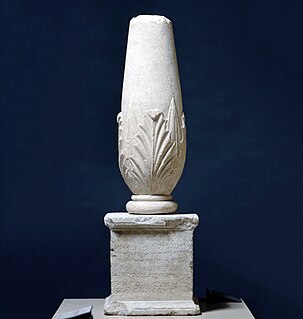 W
WThe Cippi of Melqart is the collective name for two Phoenician marble cippi that were unearthed in Malta under undocumented circumstances and dated to the 2nd century BC. These are votive offerings to the god Melqart, and are inscribed in two languages, Ancient Greek and Phoenician, and in the two corresponding scripts, the Greek and the Phoenician alphabet. They were discovered in the late 17th century, and the identification of their inscription in a letter dated 1694 made them the first Phoenician writing to be identified and published in modern times. Because they present essentially the same text, the cippi provided the key to the modern understanding of the Phoenician language. In 1758, the French scholar Jean-Jacques Barthélémy relied on their inscription, which used 17 of the 22 letters of the Phoenician alphabet, to decipher the unknown language.
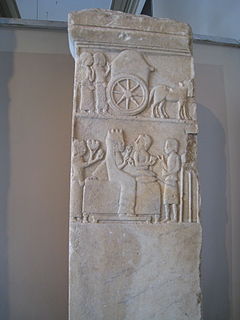 W
WThe Daskyleion steles are three marble steles discovered in 1958 in Dascylium, in northwest Turkey.
 W
WThe Deir 'Alla Inscription, known as KAI 312, was discovered during a 1967 excavation in Deir 'Alla, Jordan. It is currently at the Jordan Archaeological Museum.
 W
WThe Ekron Royal Dedicatory Inscription, or simply the Ekron inscription, is a royal dedication inscription found in its primary context in the ruins of a temple during the 1996 excavations of Ekron. It is known as KAI 286.
 W
WThe El-Kerak Inscription was discovered in 1958 in Jordan, near Wadi El-Kerak. It is a basalt inscription fragment measuring 12.5 centimeters (4.9 in) high by 14 centimeters (5.5 in) wide. The inscription has been dated to the late ninth century BC. The inscription is known as KAI 306.
 W
WThe Eshmunazar II sarcophagus is a 6th-century BC sarcophagus unearthed in 1855 in the "Phoenician Necropolis", a hypogeum complex in the southern area of the city of Sidon in modern-day Lebanon. The sarcophagus was discovered by members of the French consulate in Sidon and was donated to the Louvre. The Eshmunazar II sarcophagus has two sets of Phoenician inscriptions, one on its lid and the other on its trough, under the sarcophagus head. The lid engraving was of great significance upon its discovery; it was the first Phoenician language inscription to be discovered in Phoenicia proper, the most detailed Phoenician text ever found anywhere up to that point, and is the second longest extant Phoenician inscription after the one discovered at Karatepe.
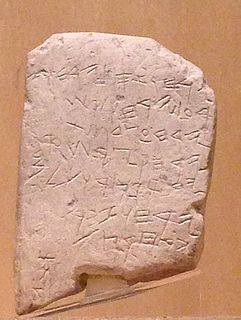 W
WThe Gezer calendar is a small limestone tablet with an early Canaanite inscription discovered in 1908 by Irish archaeologist R. A. Stewart Macalister in the ancient city of Gezer, 20 miles west of Jerusalem. It is commonly dated to the 10th century BCE, although the excavation was unstratified and its identification during the excavations was not in a "secure archaeological context", presenting uncertainty around the dating.
 W
WThe "Hadad Statue" is an 8th-century BC stele of King Panamuwa I, from the Kingdom of Bit-Gabbari in Sam'al. It is currently occupies a prominent position in the Vorderasiatisches Museum Berlin.
 W
WThe Hadad-yith'i bilingual inscription, also known as the Tell el Fakhariya Bilingual Inscription is a bilingual inscription found on a Neo-Assyrian statue of Adad-it'i/Hadd-yith'i, the king of Guzana and Sikan, which was discovered at Tell Fekheriye in Syria in the late 1970s. The inscriptions are in the Assyrian dialect of Akkadian and Aramaic, the earliest Aramaic inscription. The statue, a standing figure wearing a tunic, is made of basalt and is 2 meters tall including the base. The two inscriptions are on the skirt of the tunic, with the Akkadian inscription on the front and the Aramaic inscription on the back. The text is most likely based on an Aramaic prototype. It is the earliest known Aramaic inscription, and is known as KAI 309.
 W
WThe Honeyman inscription, also known as the Archaic Cyprus inscription, is a seven-line Phoenician gravestone inscription found in Cyprus and first published in 1939. It is the oldest detailed Phoenician inscription found in Cyprus.
 W
WThe Idalion bilingual is a bilingual Cypriot-Phoenician inscription found in 1869 in Dali, Cyprus. It was the key to the decipherment of the Cypriot syllabary, in the manner of the Rosetta Stone to hieroglyphs. The discovery of the inscription was first announced by Paul Schröder in May 1872. It is dated to 388 BCE. The Phoenician inscription is known as KAI 38 and CIS I 89.
 W
WThe Idalion Temple inscriptions are six Phoenician inscriptions found by Robert Hamilton Lang in his excavations at the Temple of Idalium in 1869, whose work there had been inspired by the discovery of the Idalion Tablet in 1850. The most famous of these inscriptions is known as the Idalion bilingual. The Phoenician inscription is known as KAI 38-40 and CIS I 89-94.
 W
WThe Kandahar Bilingual Rock Inscription,, is a famous bilingual edict in Greek and Aramaic, proclaimed and carved in stone by the Indian Maurya Empire ruler Ashoka around 260 BCE. It is the very first known inscription of Ashoka, written in year 10 of his reign, preceding all other inscriptions, including his early Minor Rock Edicts, his Barabar caves inscriptions or his Major Rock Edicts. This first inscription was written in Classical Greek and Aramaic exclusively. It was discovered in 1958, during some excavation works below a 1m high layer of rubble, and is known as KAI 279.
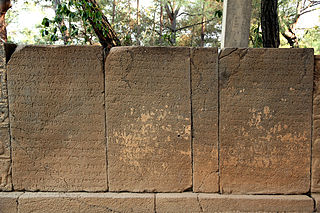 W
WThe Karatepe bilingual, also known as the Azatiwada inscription, is a bilingual inscription on stone slabs consisting of Phoenician and Luwian text each, which enabled the decryption of the Anatolian hieroglyphs. The artifacts were discovered at Karatepe, southern Turkey by the archaeologists Helmuth Theodor Bossert (1889–1961) and Halet Çambel (1916–2014) in 1946.
 W
WThe Kellia inscription is a Phoenician inscription found in the church of St Anthony in Kellia, Cyprus by Ludwig Ross in 1844. It is a funerary inscription of a noblewoman, the daughter of a Shophet. It is 1 foot wide and 2 and 3/4 feet high.
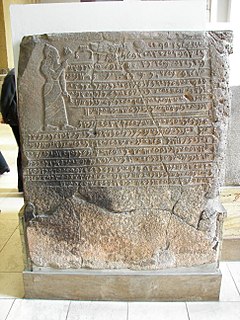 W
WThe Kilamuwa Stele is a 9th-century BC stele of King Kilamuwa, from the Kingdom of Bit-Gabbari. He claims to have succeeded where his ancestors had failed, in providing for his kingdom. The inscription is known as KAI 24.
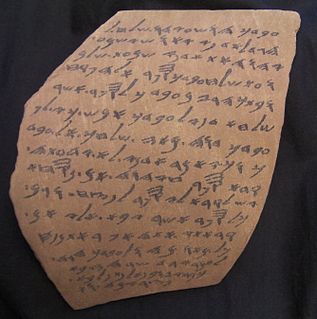 W
WThe Lachish Letters or Lachish Ostraca, sometimes called Hoshaiah Letters, are a series of letters written in carbon ink containing Canaanite inscriptions in Ancient Hebrew on clay ostraca. The letters were discovered at the excavations at Lachish.
 W
WThe Lazare Costa inscriptions are a group of Punic inscriptions found in Constantine, Algeria between 1875 and 1880 by Lazare Costa, a Constantine-based Italian antiquarian. Most of the steles are now in the Louvre.
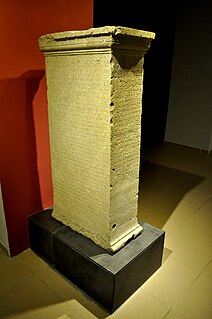 W
WThe Letoon trilingual, or Xanthos trilingual, is an inscription in three languages: standard Lycian or Lycian A, Greek, and Aramaic covering the faces of a four-sided stone stele called the Letoon Trilingual Stele, discovered in 1973 during the archeological exploration of the Letoon temple complex, near Xanthos, ancient Lycia, in present-day Turkey. It was created when Lycia was under the sway of the Persian Achaemenid Empire. The inscription is a public record of a decree authorizing the establishment of a cult, with references to the deities, and provisions for officers in the new cult. The Lycian requires 41 lines; the Greek, 35 and the Aramaic, 27. They are not word-for-word translations, but each contains some information not present in the others. The Aramaic is somewhat condensed.
 W
WThe Lilybaeum stele is a notable Phoenician gravestone stele found in Sicily and first published in 1882.
 W
WThe Limyra bilingual inscription is a 4th-century BCE bilingual Greek-Aramaic funerary inscription discovered in 1840. It was found 3km outside Limyra, in southwest Turkey.
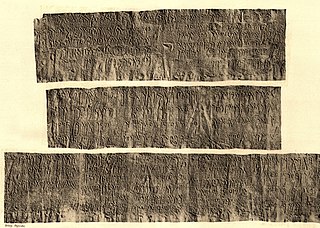 W
WThe Maktar and Mididi inscriptions are a number of Punic language inscriptions, found in the 1890s at Maktar and Mididi, Tunisia. A number of the most notable inscriptions have been collected in Kanaanäische und Aramäische Inschriften, and are known as are known as KAI 145-158.
 W
WThe Marseille Tariff is a Punic language inscription from the third century BCE, found on two fragments of a stone in 1844/45 at Marseille in Southern France. It is thought to have originally come from the temple of Baal-Saphon in Carthage. It is one of the earliest published inscriptions written in the Phoenician alphabet, and one of the longest ever found.
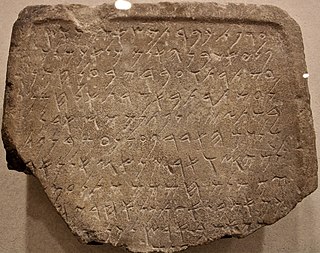 W
WThe Masub inscription is a Phoenician inscription found at Khirbet Ma'sub near the Palestinian village of Al-Bassa. It is also known as KAI 19.
 W
WThe Mesha Stele, also known as the Moabite Stone, is a stele dated around 840 BCE containing a significant Canaanite inscription in the name of King Mesha of Moab. Mesha tells how Chemosh, the god of Moab, had been angry with his people and had allowed them to be subjugated to Israel, but at length, Chemosh returned and assisted Mesha to throw off the yoke of Israel and restore the lands of Moab. Mesha describes his many building projects. It is written in a variant of the Phoenician alphabet, closely related to the Paleo-Hebrew script.
 W
WThe Neirab steles are two 8th-century BC steles with Aramaic inscriptions found in 1891 in Al-Nayrab near Aleppo, Syria. They are currently in the Louvre. They were discovered in 1891 and acquired by Charles Simon Clermont-Ganneau for the Louvre on behalf of the Commission of the Corpus Inscriptionum Semiticarum. The steles are made of black basalt, and the inscriptions note that they were funerary steles.
 W
WThe Nora Stone or Nora Inscription is an ancient Phoenician inscription found at Nora on the south coast of Sardinia in 1773. Though its precise finding place has been forgotten, it has been dated by palaeographic methods to the late 9th century to early 8th century BCE and is still considered the oldest Phoenician inscription yet found in Sardinia. It is conserved at the Museo archeologico nazionale, Cagliari. The inscription is known as KAI 46.
 W
WThe Ophel ostracon or KAI 190, is an ostracon discovered in Jerusalem in 1924 by R. A. Stewart Macalister and John Garrow Duncan, in the area of Wadi Hilweh.
 W
WThe ‘’’Panamuwa II inscription’’’ is a 9th-century BC stele of King Panamuwa II, from the Kingdom of Bit-Gabbari in Sam'al. It is currently occupies a prominent position in the Vorderasiatisches Museum Berlin.
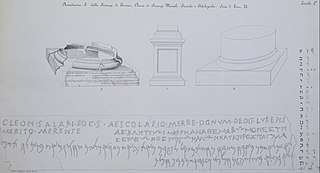 W
WThe Pauli Gerrei trilingual inscription is a trilingual Greek-Latin-Phoenician inscription on the base of a bronze column found in San Nicolò Gerrei in Sardinia in 1861. The stele was discovered by a notary named Michele Cappai, on the right side of the Strada statale 387 del Gerrei that descends towards Ballao.
 W
WThe Pococke Kition inscriptions were a group of 31 Phoenician and 2 non-Phoenician inscriptions found in Cyprus and published by Richard Pococke in 1745. In describing Kition, Pococke wrote: "the walls seem to have been very strong, and in the foundations there have been found many stones, with inscriptions on them, in an unintelligible character, which I suppose, is the antient [sic] Phoenician..."
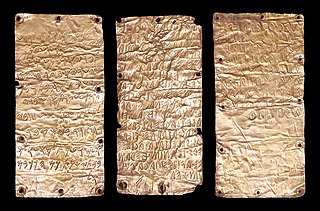 W
WThe Pyrgi Tablets are three golden plates inscribed with a bilingual Phoenician–Etruscan dedicatory text. They were discovered in 1964 during a series of excavations at the site of ancient Pyrgi, on the Tyrrhenian coast of Italy in Latium (Lazio). The text records the foundation of a temple and its dedication to the Etruscan supreme goddess Uni, who is identified with Astarte in the Phoenician text. The temple's construction is attributed to Tiberius Velianas, ruler of the nearby city of Caere.
 W
WThe Samaria Ostraca are 102 ostraca found in 1910 in excavations in Sebastia, Nablus led by George Andrew Reisner of the Harvard Semitic Museum. Of the 102, only 63 are legible. The ostraca are written in the paleo-Hebrew alphabet, which very closely resemble those of the Siloam Inscription, but show a slight development of the cursive script. The primary inscriptions are known as KAI 183–188.
 W
WThe Sardis bilingual inscription is a 4th-century BCE bilingual Lydian-Aramaic funerary inscription discovered in 1912, during the investigation by the American Society for the Excavation of Sardis. It was found in Sardis, in western Anatolia, Turkey.
 W
WThe Sfire or Sefire steles are three 8th-century BCE basalt stelae containing Aramaic inscriptions discovered near Al-Safirah ("Sfire") near Aleppo, Syria. The Sefire treaty inscriptions are the three inscriptions on the steles; they are known as KAI 222-224. A fourth stele, possibly from Sfire, is known as KAI 227.
 W
WThe Siloam inscription or Shiloah inscription known as KAI 189, is a Hebrew inscription found in the Siloam tunnel which brings water from the Gihon Spring to the Pool of Siloam, located in the City of David in East Jerusalem neighborhood of Shiloah or Silwan. The inscription records the construction of the tunnel, which has been dated to the 8th century BCE on the basis of the writing style. It is the only known ancient inscription from ancient Israel and Judah which commemorates a public construction work, despite such inscriptions being commonplace in Egyptian and Mesopotamian archaeology.
 W
WThe Stele of Serapeitis is a funerary stele with bilingual inscriptions written in Ancient Greek and Armazic, a local idiom of Aramaic, found in 1940, at Armazi, near Mtskheta, in the ancient capital of the Kingdom of Iberia. The stele memorialises a short-lived Georgian princess named Serapeitis. The inscriptions mention Georgian monarchs, Pharnavaz I and Pharasmanes II, and other members of aristocracy. The inscriptions are dated 150 AD. It is known as KAI 276.
 W
WThe Tabnit sarcophagus is the sarcophagus of the Phoenician King of Sidon Tabnit I, the father of King Eshmunazar II. The sarcophagus is decorated with two separate and unrelated inscriptions – one in Egyptian hieroglyphics and one in Phoenician script. The latter contains a curse for those who open the tomb, promising impotency and loss of an afterlife. It was created in the early 5th century BC, and was unearthed in 1887 by Osman Hamdi Bey at the Ayaa Necropolis east of Sidon together with the Alexander Sarcophagus and other related sarcophagi. Tabnit's body was found floating perfectly preserved in the original embalming fluid. Both the sarcophagus and Tabnit's decomposed skeleton are now in the Istanbul Archaeology Museums.
 W
WThe Tel Dan Stele is a fragmentary stele containing a Canaanite inscription, discovered in 1993 in Tel-Dan by Gila Cook, a member of an archaeological team lead by Avraham Biran, the pieces having been used to construct an ancient stone wall that survived into modern times. The stele is in several pieces and contains several lines of Aramaic, closely related to Hebrew and historically a common language among Jews. The surviving inscription, which dates to 9th century BCE, details that an individual killed Jehoram, the son of Ahab, king of Israel and the king of the house of David. These writings corroborate passages from the Bible, as the Second Book of Kings mentions that Jehoram, also Joram, is the son of an Israelite king, Ahab, by his Phoenician wife, Jezebel. Applying a Biblical viewpoint to the inscription, the likely candidate for having erected the stele is Hazael, an Aramean king who is mentioned in Second Book of Kings as having conquered the Land of Israel, though he was unable to take Jerusalem. The stele is currently on display at the Israel Museum, and is known as KAI 310.
 W
WThe Tel Siran inscription is an inscription on a bronze bottle found at Tel Siran on the campus of the University of Jordan in Amman). It was first published on 27 April 1972. It is considered the first complete inscription in the "Ammonite language". The bronze bottle is now in the Jordan Archaeological Museum. It is known as KAI 308.
 W
WThe Tell Halaf inscription was an ancient Aramaic description discovered in Tell Halaf in 1933, and published in 1940. The inscription was on a limestone stele. It was destroyed in November 1943 during the Battle of Berlin, when a phosphorus bomb destroyed the Tell Halaf Museum.
 W
WThe Yavne-Yam ostracon, also known as the Mesad Hashavyahu ostracon, is an ostracon containing a written appeal by a field worker to the fortress's governor regarding the confiscation of his cloak, which the writer considers to have been unjust. The artefact was found in 1960 by Joseph Naveh at Mesad Hashavyahu, near Yavne-Yam. The inscription is known as KAI 200.
 W
WThe Yehawmilk stele, de Clercq stele, or Byblos stele, also known as KAI 10 and CIS I 1, is a Phoenician inscription from c.450 BC found in Byblos at the end of Ernest Renan's Mission de Phénicie. Yehawmilk, king of Byblos, dedicated the stele to the city’s protective goddess Ba'alat Gebal.
 W
WThe Melqart stele, also known as the Ben-Hadad or Bir-Hadad stele is an Aramaic stele which was created during the 9th century BCE and was discovered in 1939 in Syria. The Old Aramaic inscription is known as KAI 201; its five lines reads:“The stele which Bir-Hadad, son of ‘Ezer, the Damascene, son of the king of Aram, erected to his Lord Melqart, to whom he made a vow and who heard his voice.”
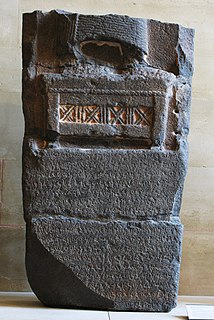 W
WThe Stele of Zakkur is a royal stele of King Zakkur of Hamath and Luhuti in the province Nuhašše of Syria, who ruled around 785 BC.